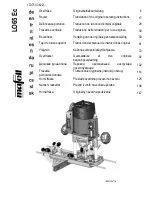
1-2
Catalyst 2928 Switch Software Configuration Guide
OL-23389-01
Chapter 1 Overview
Features
•
User-defined and Cisco-default Smartports macros for creating custom switch configurations for
simplified deployment across the network.
•
Auto Smartports
–
Cisco-default and user-defined macros for dynamic port configuration based on the device type
detected on the port.
–
Enhancements to add support for global macros, last-resort macros, event trigger control, access
points, EtherChannels, auto-QoS with Cisco Medianet, and IP phones.
•
An embedded device manager GUI for configuring and monitoring a single switch through a web
browser. For information about launching the device manager, see the getting started guide. For more
information about the device manager, see the switch online help.
•
Switch clustering technology for
–
Unified configuration, monitoring, authentication, and software upgrade of multiple,
cluster-capable switches, regardless of their geographic proximity and interconnection media,
including Ethernet, Fast Ethernet, Fast EtherChannel, small form-factor pluggable (SFP)
modules, Gigabit Ethernet, and Gigabit EtherChannel connections. For a list of cluster-capable
switches, see the release notes.
–
Automatic discovery of candidate switches and creation of clusters of up to 16 switches that can
be managed through a single IP address.
–
Extended discovery of cluster candidates that are not directly connected to the command switch.
•
Smart Install to allow a single point of management (director) in a network. You can use Smart
Install to provide zero touch image and configuration upgrade of newly deployed switches and
image and configuration downloads for any client switches. For more information, see the
Cisco
Smart Install Configuration Guide.
•
Smart Install enhancements in Cisco IOS Release 12.2(55)SE supporting client backup files,
zero-touch replacement for clients with the same product-ID, automatic generation of the image list
file, configurable file repository, hostname changes, transparent connection of the director to client,
and USB storage for image and seed configuration.
Performance Features
•
Autosensing of port speed and autonegotiation of duplex mode on all switch ports for optimizing
bandwidth
•
Automatic-medium-dependent interface crossover (auto-MDIX) capability on 10/100 and
10/100/1000 Mb/s interfaces and on 10/100/1000 BASE-TX SFP module interfaces that enables the
interface to automatically detect the required cable connection type (straight-through or crossover)
and to configure the connection appropriately
•
Support for up to 9000 bytes for frames that are bridged in hardware, and up to 2000 bytes for frames
that are bridged by software
•
IEEE 802.3x flow control on all ports (the switch does not send pause frames)
•
EtherChannel for enhanced fault tolerance and for providing up to 8 Gb/s (Gigabit EtherChannel)
or 800 Mb/s (Fast EtherChannel) full-duplex bandwidth among switches, routers, and servers
•
Port Aggregation Protocol (PAgP) and Link Aggregation Control Protocol (LACP) for automatic
creation of EtherChannel links
•
Forwarding of Layer 2 packets at Gigabit line rate
•
Per-port storm control for preventing broadcast, multicast, and unicast storms
















































